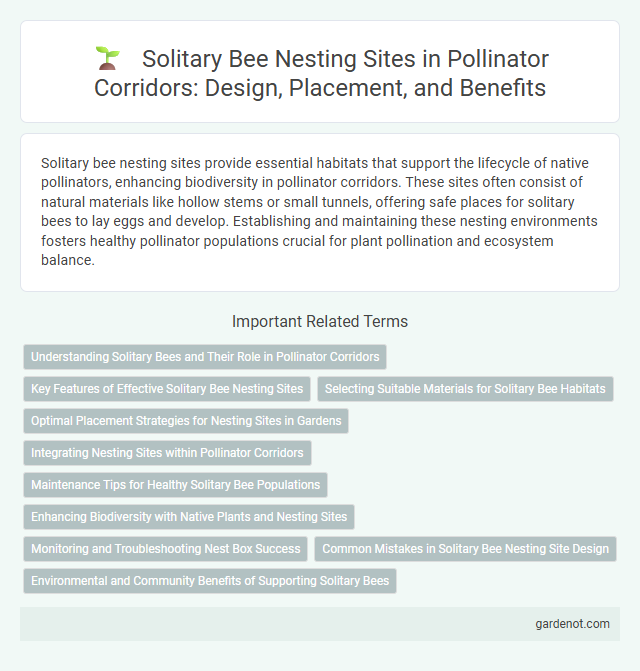Solitary bee nesting sites provide essential habitats that support the lifecycle of native pollinators, enhancing biodiversity in pollinator corridors. These sites often consist of natural materials like hollow stems or small tunnels, offering safe places for solitary bees to lay eggs and develop. Establishing and maintaining these nesting environments fosters healthy pollinator populations crucial for plant pollination and ecosystem balance.
Understanding Solitary Bees and Their Role in Pollinator Corridors
Solitary bees, unlike social bees, nest individually in small cavities or tunnels, making them vital contributors to pollinator corridors by enhancing biodiversity and pollination efficiency. Their nesting preferences include hollow stems, dead wood, and soil burrows, which support diverse habitats within these corridors. Protecting and creating suitable nesting sites for solitary bees significantly boosts pollinator populations and promotes ecosystem resilience.
Key Features of Effective Solitary Bee Nesting Sites
Effective solitary bee nesting sites feature well-drained, sandy or loamy soil with ample exposure to sunlight, creating optimal temperature for brood development. These sites often include vertical surfaces, such as bare soil banks or stacked wood, providing easy access for tunneling and protection from predators. Proximity to diverse native flowering plants ensures a continuous supply of pollen and nectar, supporting the bees' foraging needs.
Selecting Suitable Materials for Solitary Bee Habitats
Selecting suitable materials for solitary bee nesting sites involves prioritizing natural substances such as untreated wood, hollow stems, and dense plant fibers. These materials provide optimal conditions for solitary bees to create individual tunnels, ensuring adequate protection and ventilation. Proper placement of these nesting materials in sunny, sheltered locations enhances habitat usability and supports bee population growth.
Optimal Placement Strategies for Nesting Sites in Gardens
Optimal placement of solitary bee nesting sites in gardens involves positioning near diverse flowering plants to ensure consistent forage availability throughout the season. Nesting materials should be sheltered from direct sunlight and strong winds, ideally under partial shade with well-drained soil or within dead wood structures. Proximity to water sources and minimal pesticide exposure further enhance solitary bee habitat suitability and nesting success.
Integrating Nesting Sites within Pollinator Corridors
Integrating solitary bee nesting sites within pollinator corridors enhances habitat connectivity and supports diverse pollinator populations essential for ecosystem health. These sites, including hollow stems and bare soil patches, provide critical nesting resources that increase solitary bee reproduction and foraging efficiency. Strategically placed nesting habitats within corridors facilitate gene flow and population resilience by linking fragmented landscapes.
Maintenance Tips for Healthy Solitary Bee Populations
Maintaining solitary bee nesting sites involves regularly cleaning tubes or holes to prevent mold and parasite buildup, ensuring a dry and sheltered location away from direct rain and strong winds. Replace damaged or worn nesting materials annually to promote healthy reproduction cycles and monitor for signs of parasitism or disease. Providing diverse native floral resources nearby supports bees' nutritional needs essential for vigorous populations.
Enhancing Biodiversity with Native Plants and Nesting Sites
Solitary bees thrive in pollinator corridors enriched with native plants that provide essential nectar and pollen resources. Creating diverse nesting sites such as bare soil patches, dead wood, and hollow stems supports their reproductive success and population stability. Enhancing biodiversity through these habitat features fosters resilient ecosystems and improves pollination services for native flora.
Monitoring and Troubleshooting Nest Box Success
Monitoring solitary bee nesting sites involves regular inspection of nest boxes to assess occupancy rates, emergence success, and potential parasitism by natural enemies such as kleptoparasitic bees or parasitoid wasps. Troubleshooting nest box success requires addressing common issues like moisture accumulation, fungal growth, or predation by birds and ants, which can significantly reduce larval survival. Implementing strategies such as relocating boxes to drier sites, installing predator guards, and maintaining proper ventilation enhances solitary bee reproduction and supports pollinator corridor health.
Common Mistakes in Solitary Bee Nesting Site Design
Common mistakes in solitary bee nesting site design include using materials that retain excessive moisture, leading to mold and disease, and placing sites in areas with insufficient sunlight, which reduces bee activity and brood development. Nesting tubes that are too deep or narrow can hinder larval emergence and decrease occupancy rates. Avoiding these errors by selecting dry, well-ventilated locations with appropriate tube dimensions enhances the effectiveness of pollinator corridors.
Environmental and Community Benefits of Supporting Solitary Bees
Supporting solitary bee nesting sites enhances pollination efficiency, promoting biodiversity and improving agricultural yields by facilitating the reproduction of native plants. These nesting habitats contribute to environmental health by maintaining natural ecosystems and increasing resilience against climate change. Community involvement in creating and preserving solitary bee corridors fosters environmental stewardship and educates the public about sustainable practices and the crucial role of pollinators.
Solitary bee nesting site Infographic

 gardenot.com
gardenot.com